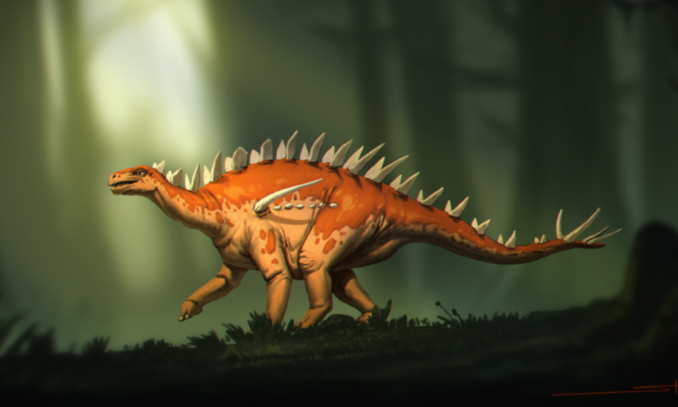
Fossil from China may be the world’s oldest stegosaur
Fossils of the dinosaur group known as Stegosauria have been discovered on all continents except Antarctica and Australia, but more than half of the 14 different species unearthed thus far have been found in China. These iconic herbivorous dinosaurs with small heads and impressive armored plates and sharp spikes on their bodies roamed the planet during the Middle and Late Jurassic period, about 170 to 145 million years ago.
Stegosaurian fossil finds are rare, and the skeletons are always incomplete, making it difficult to work out how many different species there are, and what evolutionary relationships exist between them.
A team from the Chongqing Bureau of Geological and Mineral Resource Exploration and Development in China, and London’s Natural History Museum, have now identified and named a new species, Bashanosaurus primitivus. The remains of the new stegosaur were excavated from a deposit in Chongqing, China. Its scientific name, “Bashan,” refers to the ancient name for the area of Chongqing in China where it was found.
The new species has some unique features that led the paleontologists to place it in a brand new genus. It has a smaller head and less developed shoulder blades, as well as armored plates that are narrower and have thicker bases than other stegosaurians discovered thus far. In addition, the bony point at the end of the Bashanosaurus shoulder blade is small and less well developed than in other stegosaurians, while a bony projection of the thighbone is positioned below the middle of the shaft, and the bases of the armor plates curve outwards and are thicker than the plates on the backs of its later relatives.
Interestingly, it does share some features with the very earliest armored dinosaurs, which date from 20 million years earlier, indicating that it may indeed be an early representative of the Stegosauria. The evolutionary history of this group is not well understood, so the addition of a new species contributes important and valuable knowledge.
“All these features are clues to the stegosaurs’ place on the dinosaur family tree,” said Dr. Dai Hui, who led the research. “Bashanosaurus can be distinguished from other Middle Jurassic stegosaurs, and clearly represents a new species.”
The fossilized remains of the new stegosaurian, which included bones from the back, shoulder, thigh, feet, and ribs, as well as several armor plates, have been dated to the Bajocian stage of the Middle Jurassic period, around 168 million years ago. This is much earlier than most known stegosaurians and can thus cast light on the early evolution of the group.
“Our analysis of the family tree indicates that it is one of the earliest-diverging stegosaurs along with the Chongqing Lizard (Chungkingosaurus) and Huyangosaurus. These were all unearthed from Middle to Late Jurassic Shaximiao Formation in China, suggesting that stegosaurs might have originated in Asia,” said Dr. Hui.
Well-known Stegosauria include Huayangosaurus (one of the most primitive members of the group), Gigantspinosaurus, notable for its enormous shoulder spines, and Miragaia, known for its extremely long neck. However, the fragmentary fossil material has hindered attempts to understand how the stegosaurians evolved and what the evolutionary relationships are between species.
With the discovery of this new species, however, the relationships have become clearer. Bashanosaurus primitivus has several primitive features that are similar to those of the earliest stegosaurians like Huayangosaurus and Gigantspinosaurus, as well as to early representatives of the armored dinosaurs. These features include longer tail vertebrae, a shoulder blade that is narrower and flares out, and features of the back vertebrae that are similar to the early armored dinosaur, Scelidosaurus, which lived during the Early Jurassic period.
“The discovery of this stegosaur from the Middle Jurassic of China adds to an increasing body of evidence that the group evolved in the early Middle Jurassic, or perhaps even in the Early Jurassic, and as such represent some of the earliest known bird-hipped dinosaurs,” said study co-author Dr. Susannah Maidment.
“China seems to have been a hotspot for stegosaur diversity, with numerous species now known from the Middle Jurassic right the way through until the end of the Early Cretaceous period.”
Image Credit: Banana Art Studio
The study is published in the Journal of Vertebrate Paleontology
—
By Alison Bosman, Earth.com Staff Writer












